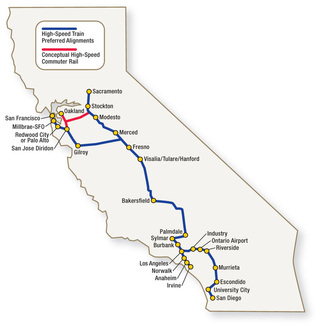- The California (CA) High Speed Rail (HSR) is the largest planned infrastructure project in America. It is projected to be the first high-speed rail system in America. The CA HSR is being planned, designed, built, and operated by the California High-Speed Rail Authority.
- Traveling at speeds just over 200 MPH, the CA HSR is proposed to run from San Francisco to Los Angeles in just under 3 hours by 2029. The CA HSR is anticipated to eventually extend to Sacramento and San Diego.
- On November 4th, 2008, Californian’s approved Proposition 1A a $9.95 billion bond that allocated funds for the California High-Speed Rail Authority. The California High-Speed Rail Authority also received $3.3 billion in federal funding.
- The cost of the CA HSR has increased from an initial estimate of $33.6 billion in 2008 to an estimated cost of $68 billion today. The CA HSR has faced sharp criticism that largely centers on its hefty price tag. The truth is, no matter how well or poorly your economy is performing, it’s never a “good time” to spend such a large amount of money. In other words, large expensive projects like this one have always faced opposition even when the benefits outweigh the costs. For example, the expensive California Aqueduct, a 700 mile system of canals, tunnels, and pipelines that brings water from the Sierra Nevada Mountains and Northern and Central California to Southern California faced enormous opposition. However, without this water system Southern California would have lacked the necessary water to grow the way it has.

- The initial construction segment will be in California’s Central Valley.
- On June 13th, 2013, the Surface Transportation Board (STB) ruled that the state could begin construction as long as it maintains the current route and follows through on promises to mitigate any potential damage to the environment caused by construction.
- The CA HSR project is expected to break ground on construction in 2013 and expected to carry passengers by 2022.
Assuming that people will ride the rail, it is reasonable to expect that smaller less developed cities will receive significant population growth and economic benefits from sharply reducing commute times to large mega-cities like Los Angeles.
Several experienced investors are already benefiting from this information. Join us at our next event to discover how properly investing near this project and several others can help you reach financial security: Event Calendar.




 RSS Feed
RSS Feed
